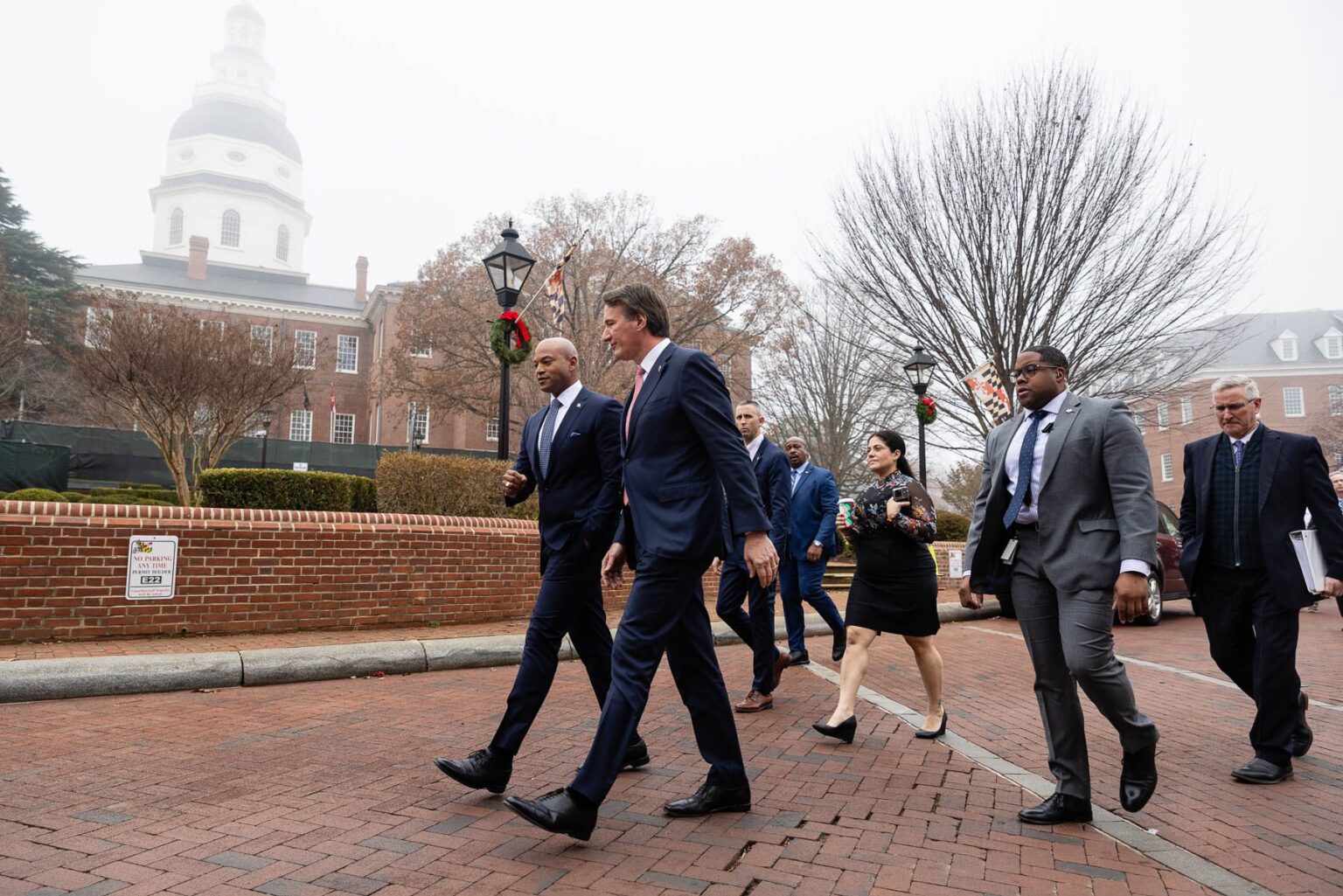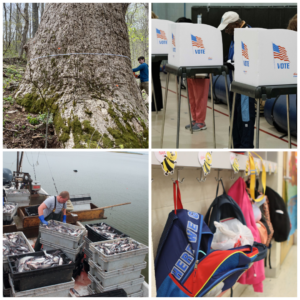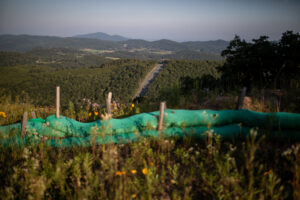18:03
News Story
With Trump presidency looming, state, federal leaders renew commitment to Bay cleanup
Maryland Gov. Moore hosts Va. Gov. Youngkin, top officials in Annapolis to retool 10-year-old Chesapeake Bay Watershed Agreement

Gov. Wes Moore leads Virginia Gov. Glenn Youngkin and officials of Chesapeake Bay watershed jurisdictions, the U.S. Environmental Protection Agency and Chesapeake Bay Commission from the Maryland State House to the annual public meeting of the Chesapeake Executive Council on Dec. 10, 2024. (Will Parson/Chesapeake Bay Program)
Top officials from all the Chesapeake Bay states and the federal government gathered in Annapolis Tuesday to reiterate their commitment to cleaning up the historically and economically critical estuary and strengthening the decade-long partnership that has helped improved the Bay’s health — even if that progress hasn’t been as swift and consistent as they might have hoped.
Maryland Gov. Wes Moore (D), seated next to Virginia Gov. Glenn Youngkin (R), with Pennsylvania Gov. Josh Shapiro (D) participating by video, convened the annual meeting of the Chesapeake Bay Executive Council, which consists of leaders of the six states in the Bay watershed, along with the District of Columbia, to retool their 10-year-old cooperative agreement at a critical juncture in the Bay cleanup.
The meeting comes just weeks before the inauguration of President-elect Donald Trump, who unsuccessfully tried to eliminate funding for Bay programs during his first term, adding an element of uncertainty for the Chesapeake’s state-based environmental stewards. But officials from red and blue states described their allegiance to the Bay cleanup as durable and unshakable Tuesday.
Moore called the Bay “the greatest heirloom clearly we have,” saying, “We did not create it. We inherited it. So it’s up to us to protect it.”
He also outlined legislation that he plans to introduce during the 2025 General Assembly session to strengthen Bay health, which he is tentatively calling the Bay Legacy Act.
The original multistate partnership, fashioned by the U.S. Environmental Protection Agency in 2014 during the Obama administration, laid out 31 goals for the Bay states and D.C. to meet by 2025. While some states have fallen short of hitting some of the marks, federal and state officials describe the program — and particularly the sense of partnership it has engendered — as an overwhelming success.
“The goals don’t need to be changed,” Youngkin said. “We just need more time to achieve them.”
The state and federal leaders did vote Tuesday to revise the watershed agreement, taking several recommendations from a steering committee of numerous stakeholders that has been meeting for more than two years. Some of the proposed changes seek to streamline the way data is collected and analyzed, and also try to heighten accountability in Bay cleanup efforts.
One proposal would place more emphasis on habitat rehabilitation throughout the Bay watershed, while another would spotlight climate impacts in the government’s ongoing scientific inquiry.
The Chesapeake Bay Program is also going to create an Agricultural Advisory Committee, to elevate the priorities of a sector that’s critical to Bay health — and a huge economic driver in the region — before the executive council.
“This allows farmers to make improvements while preserving the viability of their businesses,” Youngkin said.
The agriculture committee will complement the work of the Local Government Advisory Committee, Scientific and Technical Advisory Committee and Stakeholders Advisory Committee.
Every speaker during the public meeting Tuesday — including environmental agency officials from D.C., Delaware, West Virginia and New York, and two high-ranking EPA officials — emphasized the importance of the ongoing partnership between the states and the federal government.
“The Chesapeake Bay has always been our region’s greatest unifier, and we just saw that bipartisan support for the Bay is alive and well,” said Hilary Harp Falk, president and CEO of the Chesapeake Bay Foundation. “It’s a really big deal when three governors and leaders from around the region meet to stack hands and reaffirm commitments to clean water. This kind of local and state leadership is more critical than ever.”
Such cooperation hasn’t always been the case. In 2020, Maryland, Virginia and D.C. filed a federal lawsuitagainst the Trump administration’s EPA, accusing the agency of violating the Clean Water Act by failing to enforce Chesapeake Bay pollution reduction limits for Pennsylvania and New York.
During his speech Tuesday — he was supposed to attend the meeting in person, but was sidelined by the heavy fog that blanketed the Mid-Atlantic — Shapiro acknowledged that his state had been lagging on its commitment to Bay cleanup goals until recent years.
“It is important for me to participate in this conversation, because for a long time, Pennsylvania was on the sidelines and now we’re in the game,” he said.
And in another sign of interstate collegiality, Youngkin nominated Moore to serve another year as chair of the executive council.
Asked after the meeting about the potential impact of the incoming Trump administration on Bay cleanup efforts, Moore reiterated the states’ commitment to working together.
“We all collectively understand the importance of this work,” he said, adding, “We look forward to working with the new administration to ensure that our goals are met.”
Moore’s Bay Legacy Act
Moore, from the dais of Tuesday’s meeting, offered broad details of the legislation he’s planning to introduce in the upcoming legislative session on Bay health. Those plans were fleshed out slightly by administration officials in interviews Tuesday. They said the bill, tentatively called the Bay Legacy Act, would:
- Seek to increase regenerative farming practices in the state, particularly on land owned by the Maryland Department of Natural Resources (DNR), in part by offering long-term leases to farmers to encourage them to regenerate the soil;
- Improve aquaculture permitting in the state; and
- Strengthen water-quality monitoring programs within DNR, largely by establishing new protocols that would make it easier for the agency to work with other entities and “citizen scientists” who conduct water quality tests of their own.
Administration officials said more details on the proposed legislation could be released in a matter of days.
“We are going to continue to move forward and move fast in this state,” Moore said, “because that is what the people of Maryland demand and require.”
“We need to accomplish our water quality goals through these voluntary approaches that allow our farmers to make conservation improvements while maintaining the viability of their businesses,” Youngkin said on Tuesday, later adding that “partnership compounds effectiveness.”
After the meeting, Virginia Secretary of Natural and Historic Resources Travis Voyles acknowledged in a statement to the Mercury that technical assistance, which is the engineering component needed to get pollution reducing agricultural best management practices installed properly and counted toward cleanup goals, is important.
“Coupling technical assistance with fully funding the agricultural cost-share program is a critical component of providing farmers the tools needed to successfully implement best management practices,” Voyles said.
The directive from Youngkin also called for re-evaluating how the state’s taxpayer dollars are used, “including stormwater,” Voyles noted. One form of funding for stormwater cleanup projects is the Stormwater Local Assistance Fund, or SLAF, which was created in 2013 and has awarded matching grants to local governments for 357 projects totalling $212 million after approvals made earlier this year.
And, the directive called for the creation of a Statewide Wetlands Technical Team, led by the Department of Wildlife Resource.
Wetlands can soak up pollution before it enters waterways, but have been diminished due to development and sea level rise from climate change. Given that the watershed hasn’t been able to keep up with preserving wetlands, Virginia director of the Chesapeake Bay Commission Adrienne Kotulasaid the wetlands team will “certainly help the experts creating on-the-ground projects better align efforts, and result in increased efficiencies in their work.”
Calling the loss of wetlands her top concern for reaching cleanup goals, Kotula pointed to the $8 million in funding the Department of Wildlife Resources recently received from the National Oceanic and Atmospheric Administration through the Bipartisan Infrastructure Law to enhance the Ragged Island Wildlife Management Area along the James River as an example the wetlands team can focus on That project can be coordinated “together,” Kotula said, with the about $50 million the agency received as part of a larger appropriation from the Environmental Protection Agency to conserve wetlands.
“The question of how Virginia will address wetlands loss at the policy level remains unanswered and is critical for the Commonwealth to address,” Kotula said, roughly four weeks before the General Assembly session starts Jan. 8. — Charlie Paullin, Virginia Mercury reporter
This story was republished with permission from Maryland Matters, a nonprofit newsroom which, like The Virginia Mercury, is a part of States Newsroom.
GET THE MORNING HEADLINES.
Our stories may be republished online or in print under Creative Commons license CC BY-NC-ND 4.0. We ask that you edit only for style or to shorten, provide proper attribution and link to our website. AP and Getty images may not be republished. Please see our republishing guidelines for use of any other photos and graphics.




